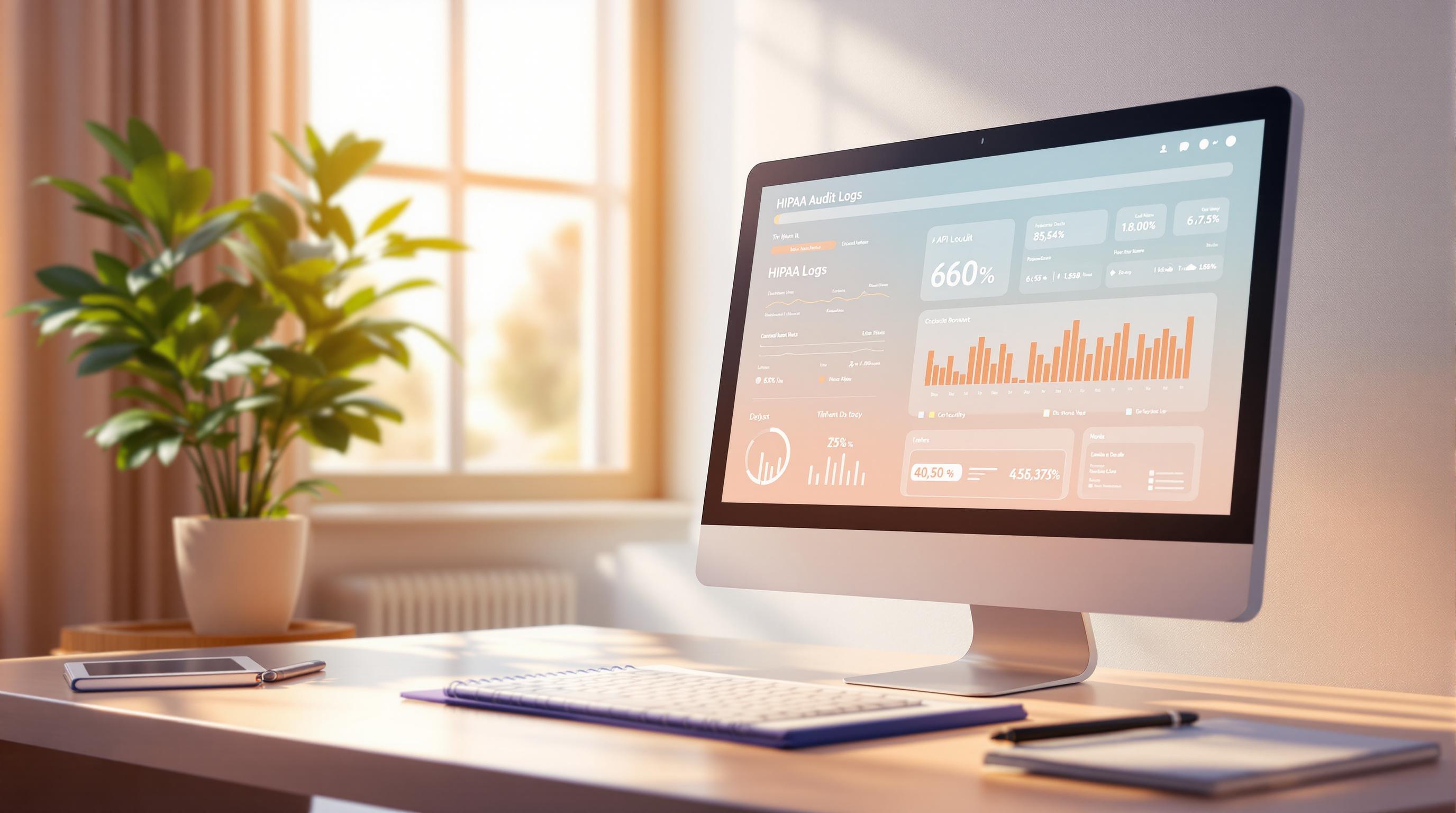HIPAA Audit Logs: API Security Best Practices


Key Takeaways
HIPAA Audit Logs: API Security Best Practices
HIPAA-compliant API audit logs are essential for protecting sensitive healthcare data. They track who accessed data, when, and what actions were taken, ensuring accountability and compliance with HIPAA regulations. Here’s what you need to know:
- Key Audit Log Components:
- User ID, timestamps, action details, resource info, access location, and outcome status.
- HIPAA Requirements:
- Logs must be retained for 6 years and stored securely (e.g., encrypted servers).
- How to Strengthen Security:
- Steps to Implement:
- Log every API interaction.
- Encrypt and secure logs.
- Continuously monitor API activity.
HIPAA Security Audit: A Complete Guide
HIPAA Audit Log Requirements Explained
HIPAA audit log requirements set clear standards for tracking and monitoring access to electronic protected health information (ePHI). These rules are key to helping healthcare organizations stay compliant while safeguarding sensitive patient data.
Components of HIPAA Audit Logs
Key elements like User Authentication and Event Details are essential for meeting HIPAA standards. The National Institute of Standards and Technology (NIST) offers detailed guidance in Special Publication 800-66, explaining how these components address regulatory needs:
- User Authentication: Ensures accountability by requiring unique user IDs.
- Event Details: Tracks when records are created, edited, or deleted.
- System Access: Logs login attempts and changes to user permissions.
- Data Access: Monitors activity involving files, databases, and directories.
- Network Activity: Captures logs from firewalls and other security events.
HIPAA mandates that audit logs be kept for six years to support incident investigations and demonstrate compliance [1][2]. To protect log integrity, organizations should use encrypted servers or secure cloud storage and regularly review logs to spot potential risks [3].
Using SIEM Systems with Audit Logs
Security Information and Event Management (SIEM) systems improve HIPAA audit logging by offering centralized monitoring and real-time threat detection. These systems turn raw log data into actionable insights through:
- Centralized Monitoring: Combines logs from multiple systems into one location.
- Automated Alerts: Flags suspicious activities for immediate attention.
To use SIEM systems effectively while staying HIPAA-compliant, organizations should limit the amount of PHI included in audit logs. This reduces the risk of unauthorized access during security incidents while ensuring proper monitoring [5]. By adopting these practices and integrating SIEM systems, healthcare organizations can strengthen their security measures and meet HIPAA requirements.
Steps to Implement HIPAA-Compliant API Logging and Monitoring
Following these steps helps meet HIPAA requirements and strengthens the security of healthcare APIs, safeguarding sensitive patient information.
Detailed API Logging
It's crucial to log every API interaction thoroughly. This includes recording:
- Unique user IDs for all authentication attempts (both successful and failed)
- Timestamps for each interaction
- Access type (e.g., read, write, modify, delete)
- Specific resources accessed and any data changes
- Source IP addresses or locations
This level of detail ensures accountability and traceability for all API activity.
Protecting and Storing Logs Securely
Audit logs must be stored securely to prevent tampering or unauthorized access. Key measures include:
- Encrypting logs both during transmission and while stored
- Using tamper-proof storage solutions, such as append-only systems or blockchain
- Applying strict access controls to limit who can view or modify logs
Ongoing API Monitoring
Continuous monitoring is essential for staying HIPAA-compliant and protecting healthcare data.
| Monitoring Component | Purpose | How to Implement |
|---|---|---|
| Real-time Analysis | Identify unusual activity | Integrate with SIEM systems for automated threat detection |
| Access Control & Alerts | Stop unauthorized access and respond quickly | Use role-based access control (RBAC) and set alert thresholds |
To make monitoring effective, consider these practices:
- Use SIEM systems to connect API logs with other security data, creating a more comprehensive view of potential threats.
- Regularly review access logs and permissions to spot irregularities.
- Conduct periodic security audits of the API infrastructure.
For added security, implement OAuth 2.0 and OpenID Connect protocols to manage API access. These protocols ensure detailed authentication logs are maintained [4].
Once logging and monitoring are in place, the next step is to enhance API security with stronger authentication methods, API gateways, and automated threat detection tools.
sbb-itb-8f61039
API Security Strategies in Healthcare
Healthcare organizations must implement strong security measures to safeguard sensitive patient data accessed via APIs. These measures should align with HIPAA regulations while ensuring systems remain efficient and operational.
Secure Authentication and Authorization
Using OAuth 2.0 and OpenID Connect protocols is essential for securely managing user access. These frameworks ensure proper token management, identity verification, and detailed logging to meet compliance requirements.
Important practices include:
- Multi-factor authentication (MFA) and biometric verification for added security.
- Role-based access control (RBAC) to restrict access to only what users need for their specific roles.
- Regularly reviewing and updating access permissions to prevent unauthorized access.
API Gateways and Security
API gateways act as centralized hubs to enforce security policies and manage access. They handle SSL/TLS certificates to ensure encrypted communication and use rate limiting to protect against brute force or denial-of-service (DoS) attacks. Key features include:
- Blocking suspicious activity through IP filtering.
- Enforcing security policies and access control rules.
- Providing advanced monitoring tools to support compliance efforts.
Automated Threat Detection
AI and machine learning systems play a critical role in identifying and addressing risks by analyzing traffic patterns. These systems help healthcare organizations stay HIPAA-compliant by offering:
- Traffic pattern recognition to detect unusual API access attempts.
- Automated responses to potential breaches.
- Real-time alerts for security teams to act quickly.
Regular audits of API security measures are crucial for staying compliant. These audits should include reviewing access logs, updating protocols, and training staff on security best practices [4].
"Implementing strong authentication protocols and least privilege access is crucial for HIPAA compliance" [4].
PatientPartner: Secure Solutions for Patient Support

PatientPartner provides a HIPAA-compliant SaaS platform designed to help pharmaceutical and med-tech companies deliver secure patient mentorship programs. The platform includes robust security features like audit logging, real-time monitoring, secure data storage, and role-based access controls. These measures ensure regulatory compliance while supporting patient-focused services.
The platform highlights effective use of HIPAA-compliant API security through:
- Secure API gateways to control data access
- Encrypted data transmission for safe information exchange
- Ongoing compliance monitoring across connected healthcare systems
- Detailed documentation of patient-mentor interactions
With these tools, pharmaceutical companies can:
- Ensure HIPAA compliance throughout their digital systems
- Monitor patient engagement metrics without compromising privacy
- Facilitate secure communication between mentors and healthcare providers
- Keep detailed records of system interactions for compliance checks
PatientPartner's design shows how healthcare organizations can meet compliance standards without sacrificing efficiency. By blending proven security protocols with smooth system integration, it sets an example for effective API security in healthcare technology. This balance allows organizations to protect sensitive data while delivering essential patient support services.
This approach reflects broader API security practices, proving that technical safeguards can address both regulatory demands and the practical needs of healthcare delivery.
Conclusion: Key Points on API Security and Compliance
To wrap up, let’s revisit the key elements of API security and their role in meeting HIPAA standards. Protecting sensitive healthcare data requires a careful balance of security protocols, compliance measures, and operational efficiency.
Core Security Measures
Detailed audit logs play a crucial role in ensuring accountability and traceability. As mentioned earlier, organizations must retain these logs for at least six years to meet HIPAA requirements, documenting all system interactions effectively.
Implementation Priorities
Healthcare organizations should focus on the following:
- Strong authentication methods
- Limiting the inclusion of PHI in logs
- Using tools for continuous monitoring
Managing Risks and Ensuring Compliance
Regular risk assessments help ensure that logging practices remain effective without interfering with healthcare operations. Together, audit logging, API gateway protection, and ongoing monitoring create a strong foundation for secure and compliant APIs.
Platforms like PatientPartner showcase how these strategies can support patient-focused healthcare solutions. By combining robust security protocols with thorough documentation and frequent evaluations, healthcare organizations can protect sensitive data while meeting HIPAA standards.
This structured approach allows healthcare providers to deliver reliable services while safeguarding patient data, ensuring both security and compliance are maintained.
FAQs
Is API HIPAA compliant?
APIs themselves aren't automatically HIPAA compliant. Compliance depends on how they're implemented and secured, especially with measures like audit logging, secure gateways, and monitoring.
To meet HIPAA requirements, APIs should include:
- Audit Logging: Record details like user IDs, timestamps, actions, and accessed resources in API logs [3].
- Security Measures: Use API gateways to handle:
- Centralized logging
- Access control
- Real-time traffic checks
- Secure user authentication
HIPAA-compliant APIs must log all interactions securely, retain records for six years, and rely on gateways to manage security and monitoring.
Best Practices for Staying Compliant
The NIST Special Publication 800-66 outlines solid strategies for secure audit logging [3]. Organizations should focus on:
- Tracking database changes involving PHI
- Monitoring permission updates
- Logging access to sensitive files
- Keeping tabs on firewall and security activities
"Audit logs must be tamper-proof and securely stored for compliance and investigations" [3].
Author



